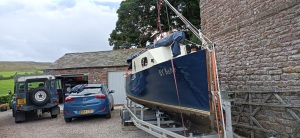moving swiftly onwards – as it feels like the end is coming into view I pushed on with painting the iron bits, and getting towards finishing the valve gear…
Painting
I had purchased a copy of “How not to Paint your loco” by Christopher Vine. This book is worth purchasing on three grounds:
- One – it is beautifully printed on lovely paper with gorgeous pictures of a fabulous model.
- Two – It is chuck full of great advice on obtaining an exhibition gold-medal winning finish on models (or other stuff) – and if (like me) you spend 20+ years building a model , you might as well finish it nicely!
- Three – it is one of the most complete examples of the obsessive at work. This man cuts up and paints (from memory) about 400 bits of metal just to check what happens for any combination of % thinner, number of coats, time between coats and spray pressure – it is a complete triumph of obsession-driven commitment to providing the exhaustive analysis of a subject – bloody brilliant, and very english!
anyway, it had helped me produce what felt like a moderate success of painting the gresley …
…and this resulted in a too casual attitude to spraying “a few simple bits for the engine”.

Following a coat of primer, tried spraying with synthetic enamel – Precisions Paints, not looking good too much/wrong time of thinners.
Having mulled over what colour to do it (not too dark as my failing sight would make it hard to see what’s happening), and being dissuaded from the JCB yellow I had painted the Quorn cutter grinder (looks great, but not very “maritime”) I decided to go for the Gresley/LNER Apple Green I had purchased from Precision Paints. But the initial results looked somewhat iffy.
I think too much, and the wrong sort of thinners produced a rather wishy/washy result.
Having gotten used to the car Cellulose paint paint which I had used on the loco and tended to be dry as it touched the job, this remained wet for a long time (the snowy conditions also meant it was WAY too cold to be painting) – but I think I got away with it – the paint did dry, and did seem to look a better colour, so a few more coats should get us there. However, as you can see in the shot, there is a “spot” on the LP lower cylinder cover where the primer failed… probably needs a trip to the sand blasting cabinet and then better degreasing before a re-try.
Eccentrics
Between coats, I started on the eccentrics and straps. The initial cuts on the eccentrics are easy, but not sure the sequence ofd work I planned on the straps was so smart. I cut them in half (bandsaw), and then faced up the edges (shaper) and then “co-ordinate drilled” the bolt holes in the lower half (vertical mill). I am just no sure if I should now clamp them in pairs and use the lower half holes to pilot drill the upper part, or drill the upper parts on the mill and then clamp and ream the results… I’ll make a decision soon!
-

-
Truing up the chucking spiggot and backplate
-

-
Starting on Eccentrics and Straps – first cut on eccentrics, and halving the strap castings
-

-
shaping machine (with new drive) cleaning up the mating faces of the eccentric halves.
-

-
checking we have the eccentric strap halves truly flat in mill
-

-
lining the first hole up with Mark I eye-ball to scribed line and center-punched mark.
-

-
drilling second hole 3.7500 (by DRO) from the first
Slide Valve
The slide valve is a balanced slide valve, and the words in Mr Leek’s book are a verbatim

this is a nice piece of design, but must confess I struggled with the drawings – but a finished pic helps clarify the assembly.
copy of the section in an old text book I have (either by Henry Greenley or Martin Evans…neither of which I can find in my library right now)…. either way there are two “novel ideas” in the design.
- The valve is sandwiched between the port-face and the valve-chest cover. This masks most of the surface area of the valve from steam pressure, and thereby significantly reduces the forces pressing the valve on to the port-face, and thus reduces the loading on the valve gear, and…
- allows the exhaust steam to exit via the valve and the valve-chest cover. Thus significantly simplifying porting, gas flow and port length. It’s a very elegant design attributed to Sir John Audley Frederick Aspinal CME who served as Locomotive Superintendent of the Great Southern and Western and Lancashire and Yorkshire Railways. – but was actually invented, I believe, by George W Richardson from the USA! (I suspect the British engineers of the 1890’s were not too ready to attribute new/good ideas to some “upstart from the colonies”!)
The above picture shows it assembled (without valve chest cover – you’re looking down the exhaust port, and can just make out the top edge of the lower port on the port face at the end of the port).











